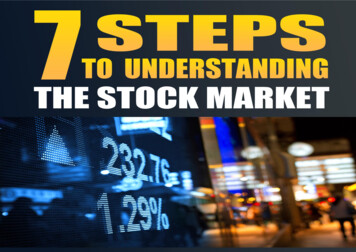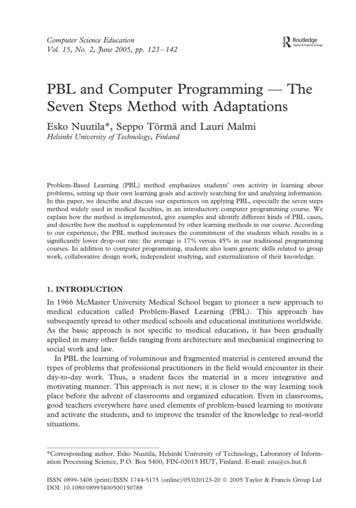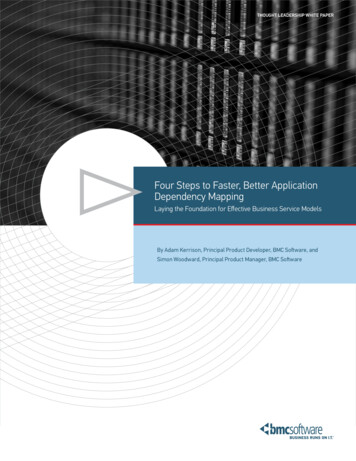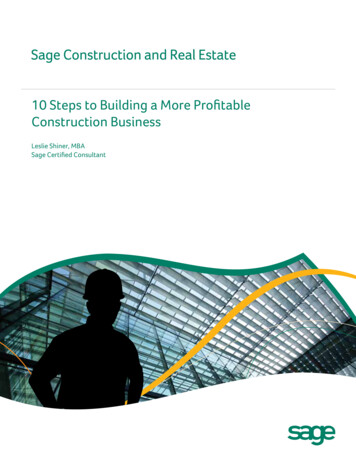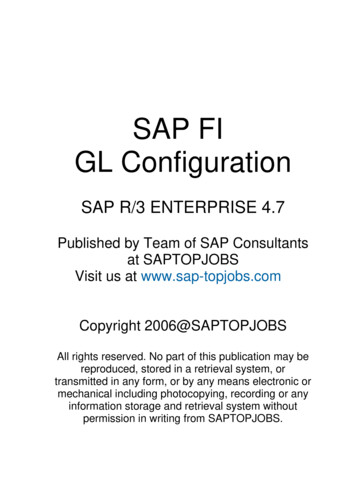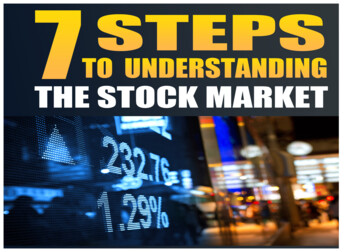
Transcription
Investing for Beginners 101: 7 Steps to Understanding the Stock Market7 Steps to Understanding theStock MarketThe Investing for Beginners 101 GuideCopyright: www.einvestingforbeginners.comPublished: April 27, 2013. All Rights Reserved.Information in this eBook should not be construed as investment advice. The work is based onSEC filings and should not be seen as a solicitation to buy or sell certain securities. The author isnot a lawyer, an accountant, or a financial planner. Any suggestions are not intended to solve anyparticular financial situation and you should also seek the services of a certified professional.The information in this guide should be considered for informational purposes only. There are linkscontained in this guide that may benefit the author financially. The author does not assumeresponsibility for any Third Party material or opinions that may be present in the guide.No parts of this publication may be reproduced or distributed without the express written consentof the author. All registered trademarks in this guide are property of their respective owners.All readers of this guide must do their own due diligence and accept that the author does not takeresponsibility for the success or failure of your investment or business decisions. As of the date ofpublication, the author does not hold any positions in the securities discussed in this guide.www.einvestingforbeginners.com 2
Investing for Beginners 101: 7 Steps to Understanding the Stock MarketWelcome to my Free Guide!In a market driven by emotions like fear andgreed, I present to investors a simplenumbers-based approach to consistentlypicking good stocks. I’m an electrical engineerat a Fortune 500 company with a fiery passionfor numbers and value investing.about the stock market, to give them all thetools they need to make smart investingdecisions.Easy to follow and full of value, I’ve createdthe course for people of all ages to be able tounderstand, leaving out all the Wall Streetjargon. Young investors have such anadvantage if they just start now, and I hopeto motivate as many people as I can to followthis path to wealth.My investing strategy centers on valueinvesting and is heavily influenced byBenjamin Graham, Warren Buffett, andinvesting podcasts and books.Instead of attempting to reinvent the wheel,my 7 Steps to Understanding the StockMarket guide integrates proven andsuccessful investing strategies.I’ve developed the Investing for Beginners101 guide to give those who know nothingI don’t have a billion dollar portfolio, I’m not awildly successful hedge fund manager, and Ieven don’t have decades of experience. But Ido take my research very seriously and haveinnovated on everything I’ve learned. Enjoy.www.einvestingforbeginners.com 3
Investing for Beginners 101: 7 Steps to Understanding the Stock MarketContentsStep 1 to Understanding the Stock Market . .5The Rule of 72 Exercise . . .7Step 2/7: How the Stock Market Works . .8Step 3/7: The BEST Stock Strategy and Buying Your First Stock .14Step 4/7: How To Calculate P/E Ratio . .21Step 5/7: The Single Two Factors Most Correlated To Success .25Step 6/7: Cashing In With A Dividend Is A Necessity .30Step 7/7: The Best Way To Avoid Risk & Putting It All Together .36www.einvestingforbeginners.com 4
Investing for Beginners 101: 7 Steps to Understanding the Stock MarketInvesting for Beginners 101:7 Steps to Understandingthe Stock MarketWelcome to this easy 7 step guide tounderstanding the stock market, Investing forBeginners 101. I’ve created the easy to followInvesting for Beginners guide to simplify thelearning process for entering the stockmarket. By leaving out all the confusing WallStreet jargon and explaining things in simpleterms, Investing for Beginners 101 is theperfect solution for those willing to learn.Before we get started, here is a breakdown ofthe 7 categories for the first official Investingfor Beginners guide.1. Why to Invest?2. How the Stock Market Works3. BEST Stock Strategy; Buying Your First Stock4. How to Calculate the Most Used Valuation5. The Single Two Ratios Correlated to Success6. Cashing In With a Dividend Is a Necessity7. The Best Way to Avoid Risk, and Putting it allTogether!Why is investing so important?Let’s imagine a life without investing first. Youwork 9-5 for a boss all your life, maybe get acouple of raises, a promotion, have a nicehouse, car, and kids. You go on vacation oncea year, eat out regularly, and attempt to enjoythe finer things in life as best you can.Now since you haven’t invested, you get old,become unattractive for hiring, and live with ameasly social security allowance for the rest ofyour life. You might’ve made good moneywhen you were young, but now you havenothing to show for your lifetime of work.Now let’s say you did save some money forretirement, but again this money wasn’tinvested and won’t be invested. Let’s evenstay optimistic and assume you saved 1400a month for 26 years. This would leave youwith 403,200 to live on, which on a 60,000a year lifestyle would only last you 6.72 years.You’re retiring at 65 only to go broke at 71and you’ve been a good saver all your life.Well then what’s the point of saving, you maywww.einvestingforbeginners.com 5
Investing for Beginners 101: 7 Steps to Understanding the Stock Marketask? Now let me show you the same numbersbut add investing into the equation.Again, let’s say you saved 1400 a month for26 years. BUT, this money was investedcontinuously as part of a long-terminvestment plan, solid in the fundamentalsyou learned from Investing for Beginners 101.Now, including dividends in long-term stockmarket investments, I can confidently andconservatively say that you can average a10% annual return on these investments.The same 1400 a month compoundedannually at 10% turns your net worth into 2,017,670.19 in 26 years! But the storygets even better. With this large sum ofmoney at your retirement, againconservatively assuming a 3% yield on yourdividends, you can collect 60,530 a year tolive on WITHOUT reducing your savedamount.See the graph to the right to get a visualpicture of the staggering difference.Answer: Compounding InterestBy letting the power of compounding interestassist you in saving, you leverage theresources available in the market and slowlybuild wealth over time. It’s not some mystifiedsecret or get-rich-quick shortcut; this is atime tested method to become wealthy andbe financially independent, and it’s howbillionaires like Warren Buffett have done it alltheir life.www.einvestingforbeginners.com 6
Investing for Beginners 101: 7 Steps to Understanding the Stock MarketFor those who don’t want to think abouttomorrow, I can’t help you. But tomorrow willcome, it always does. Would you rather spendthe rest of your life with no plan, dependenton others and unsure of your future? Or wouldyou rather be making progress towards agoal, living with purpose and anticipating thefruits of your labor you know you will bereaping for years after you sow?The choice is yours, and only YOU will feel theconsequences of that choice.The Rule of 72 ExerciseThe Rule of 72 is a simple way to quicklycalculate how long it will take for aninvestment to double, based on compoundinginterest.As I referred to in the previous section,compounding interest works its wonders byearning interest on capital, than earninginterest on the interest of that capital, thusmultiplying the amount of money able to besaved each and every year thereafter.We want the ability to calculate how muchinterest we could earn on an averageinvestment in order to plan sufficiently andcreate goals for that investment plan.The equation for calculating how long it takesan investment to double is as follows:[ 72 / (interest %) ] # of years to doubleSo, for our previous example of 10%compounded annually, it takes our money 7.2years to double.72 / 10 7.2 yearsIn a period of 26 years, our money doubles3.6 times. When adding in the monthlyadditions, this is how 1,400 a monthbecomes 2,017,670.19.The best way to learn is by doing. Work onthis exercise and then read the answer in thenext exercise section. How long until yourmoney doubles at 12% annually?www.einvestingforbeginners.com 7
Investing for Beginners 101: 7 Steps to Understanding the Stock MarketStep 2/7: How the StockMarket WorksThe saying goes that knowing is half thebattle, and the same is true with investing inthe stock market. By yearning to educateyourself about how to invest and build wealth,you are already halfway to your goal.My job as your teacher is to build a foundationof educational wisdom that can be broadlyused to earn money and understand any stockmarket strategy presented to you. I hope thisguide is as entertaining and easy to follow ascan be.In order to understand investing, you mustunderstand how the general principles behindthe stock market work. Before I startedresearching and reading about investing, theonly things I knew about the stock marketwere what I saw on TV or heard on the news,and it was never positive.Stock Market is OverdramatizedI remember hearing about the disaster of theFacebook IPO (initial public opening, when thestock is first able to be bought by the public),the failures of Freddie and Fannie Mae andhow stocks tumbled afterwards, and the greatdot com bubble that burst in 2000.With each stock market crash or failure, thereare lots of emotional stories about everydaypeople losing everything they had or big,greedy corporate leaders succumbing to thefall of their empire.Because of my limited knowledge of the stockmarket, I pictured it as full of Gordon Gekkobusinessmen types (from Wall Street: MoneyNever Sleeps) with money spilling out of theirears and lives full of fast action and New Yorkspeed trading. Hollywood depicts Wall Streetas this extreme roller coaster ride wherefortunes are won and lost every instant, whenin reality this isn’t the case. Yes, the stockmarket has ups and downs, there is riskinvolved, and some people do get burnedwww.einvestingforbeginners.com 8
Investing for Beginners 101: 7 Steps to Understanding the Stock Marketbadly, but the majority of successful investorstake very boring and safe strategies straightto success, because they understand the basicprinciples and are educated on how to stayout of risky investments.bit, anyone can clearly derive that investorslost less than half their worth during thatyear. But as you can see from the graphbelow, the S&P quickly recovered lost groundafter the ’08 fall.Reality: The Market FluctuatesIn fact, periods of time where the price fallsare common. An important aspect of investingis knowing that stock prices do fluctuate upand down but when held over long periods oftime, the chances of capital gainsexponentially increases.I feel like I must give the reader someperspective to the reality of the stock market,so you can understand that the big flashynews headlines and TV specials are extremelyoverdramatized. The S&P 500 is a list of thetop 500 stocks in the U.S., and is widelyaccepted as the benchmark for all stockinvestments; analysts consistently compareperformance to that of the S&P 500. The S&P500 is an index that you can think of that issimilar to the DOW, which only has 30companies. Now, the worst one day loss forthe S&P 500 in 2008 was only -9.03%. Intotal for the year, the S&P 500 lost -38.49%,which was the worst year the index has everhad.If you think about these numbers for a littlewww.einvestingforbeginners.com 9
Investing for Beginners 101: 7 Steps to Understanding the Stock MarketReality: Media Coversthe ExtremeAs you can see, the majority of investorsaren’t in fact losing their shirts and the mediais choosing to cover extreme cases of peoplelosing money in the stock market, simplybecause they make for good stories and goodTV. Those who did lose all their money weren’tdiversified in their investments, bought stockin companies that were over leveraged,borrowed money to purchase stocks, or acombination of all three.For those investors who didn’t sell their stocksin 2008, which would’ve been the worst timeto bail out of your stocks, the marketrecovered and the “devastating losses” didn’taffect their portfolio. Therein lies theimportance of long-term investing and ridingout the storms. Since its inception in 1957,the S&P 500 has returned on average 10.83%annually, when dividends are automaticallyreinvested.For those who need a reminder on howpowerful a compounding 10% return can be,recall my 2 million example. In 40 years, thisamount becomes 8,179,114!Smart Investors Don’tListen to NoiseSo Investing for Beginners fans, please don’tforget that a stock is meant to be a long-terminvestment. It will pay you dividends that overtime will compound and multiply, and ifinvested in a good company the share pricewill appreciate substantially as well. Asfinancial guru Dave Ramsey simply puts it,“The only people who get hurt riding a rollercoaster are the ones that jump off.” Once yougain the confidence to have convictions inyour investments - knowing that they willrecover when hit badly - you will easily beable to avoid selling your stocks at the worstpossible time, when the market has atemporary crash and it seems like everyoneelse around you is doing it.www.einvestingforbeginners.com 10
Investing for Beginners 101: 7 Steps to Understanding the Stock MarketBefore I introduce the more in-depth topics ofthis guide, I feel I must explain how I derivedthese categories and why they are relevant toyou. While the Value Trap Indicator I teach ismy own original invention, the fundamentalideas and ratios are all well known and widelyused by millions of investors around the worldand countless investing gurus and authors. Infact, if you get around to reading enoughinvesting and stock market books you’ll realizethey are almost all the same, and many of thevarious ways institutional investors evaluate astock run par
Investing for Beginners 101: 7 Steps to Understanding the Stock Market www.einvestingforbeginners.com 8 Step 2/7: How the Stock Market Works The saying goes that knowing is half the battle, and the same is true with investing in the stock market. By yearning to educate yourself about how
